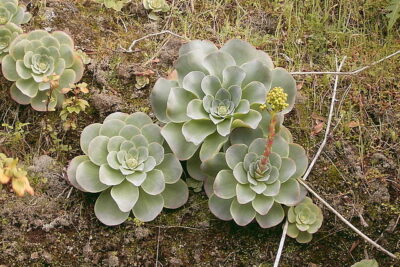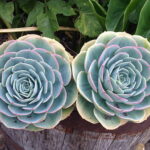
Can Succulents Survive Outdoors Year-Round?

Succulents have become increasingly popular in recent years, adored for their unique shapes, vibrant colors, and low maintenance requirements. These desert-loving plants are known for their ability to store water in their leaves, stems, and roots, making them well-suited for dry climates and indoor environments. However, many succulent enthusiasts wonder if these resilient plants can survive outdoors year-round, especially in regions with colder winters or more extreme weather conditions.
We will explore the hardiness of succulents and their ability to withstand outdoor conditions throughout the year. We will discuss the factors that contribute to their survival, such as species selection, proper planting techniques, and protective measures. Additionally, we will provide tips and guidelines for caring for outdoor succulents, including watering, fertilizing, and winterizing strategies. Whether you are a seasoned succulent gardener or just starting out, this article will help you understand how to best care for your succulents in an outdoor setting.
- Yes, succulents can survive outdoors year-round in warm climates
- Succulents can tolerate a wide range of temperatures, from hot summers to mild winters
- Planting succulents in well-draining soil and providing them with proper sunlight can help them thrive outside
- In colder climates, some succulents may need to be brought indoors during the winter months
- Protecting succulents from frost and extreme cold is essential for their survival
- Mulching around the base of succulents can help insulate them and protect the roots during winter
- Watering succulents sparingly during the winter can prevent root rot and other issues
- Choosing cold-hardy succulent varieties can increase their chances of surviving outdoors year-round
- Monitoring succulents for signs of stress or damage and taking appropriate action can help them survive and thrive
Yes, succulents can survive outdoors year-round in warm climates
One common misconception about succulents is that they can only survive indoors or during certain seasons. However, in warm climates, succulents have the ability to thrive outdoors year-round. With their unique adaptations to arid conditions, succulents are well-suited to withstand the challenges of outdoor environments.
Succulents are known for their ability to store water in their leaves, stems, and roots, which allows them to survive in dry conditions. This adaptation enables them to withstand periods of drought and makes them ideal for outdoor gardens in warm climates.
Factors for successful outdoor cultivation
While succulents can survive outdoors year-round in warm climates, there are some important factors to consider for their successful cultivation:
- Sunlight: Succulents thrive in bright, direct sunlight. Make sure to choose a location in your outdoor garden that receives at least six hours of sunlight per day.
- Well-draining soil: Succulents require soil that allows excess water to drain quickly. Use a well-draining soil mix specifically formulated for succulents or add perlite or sand to improve drainage.
- Watering: While succulents are drought-tolerant, they still require regular watering. Water your outdoor succulents thoroughly when the top inch of soil feels dry, but avoid overwatering, as this can lead to root rot.
- Protection from frost: While succulents can handle warmer temperatures, they are generally not frost-tolerant. If you live in an area where frost is a concern, it is advisable to bring your succulents indoors or provide them with protection during colder months.
Popular outdoor succulent varieties
There are numerous succulent varieties that are well-suited for outdoor cultivation. Some popular choices include:
 Indoor Succulent Care: Expert Tips for Blue Succulents
Indoor Succulent Care: Expert Tips for Blue Succulents- Aloe vera: Known for its healing properties, aloe vera is a versatile succulent that thrives in warm outdoor climates.
- Echeveria: With their rosette-shaped leaves and vibrant colors, echeverias are a popular choice for outdoor succulent gardens.
- Sedum: Sedums are hardy succulents that come in various shapes and sizes, making them perfect for outdoor landscaping.
- Agave: Agaves are striking succulents with spiky leaves that add a dramatic touch to any outdoor garden.
With proper care and attention to their specific needs, succulents can not only survive but thrive outdoors year-round in warm climates. So, if you live in a region with a warm climate, don't hesitate to incorporate these beautiful and low-maintenance plants into your outdoor garden!
Succulents can tolerate a wide range of temperatures, from hot summers to mild winters
Succulents are known for their ability to survive in harsh conditions, making them popular choices for both indoor and outdoor gardens. One frequently asked question among succulent enthusiasts is whether these plants can survive outdoors year-round. The good news is that many succulent species can indeed tolerate a wide range of temperatures, from hot summers to mild winters.
One of the main factors that allow succulents to thrive outdoors is their ability to store water in their fleshy leaves and stems. This adaptation helps them withstand periods of drought and heat, as they can sustain themselves using the stored water. However, it's important to note that not all succulents are equally suited for outdoor cultivation in all climates.
Choosing the right succulents for outdoor cultivation
When considering whether your succulents can survive outdoors year-round, it's important to select the right species for your specific climate. Some succulents are more cold-hardy and can tolerate freezing temperatures, while others are more suited to warm and tropical climates.
For areas with mild winters and hot summers, a wide variety of succulents can thrive outdoors. Popular choices include Aloe vera, Sedum, Echeveria, and Sempervivum. These succulents are known for their ability to adapt to different weather conditions and can handle both high temperatures and occasional frost.
If you live in a region with harsh winters, it's important to choose cold-hardy succulents that can withstand freezing temperatures. Some cold-hardy succulents include Agave, Yucca, and Opuntia. These species have evolved to survive in more extreme climates and can tolerate cold temperatures without damage.
 Indoor or Outdoor: Maximizing Succulent Growth for Optimal Results
Indoor or Outdoor: Maximizing Succulent Growth for Optimal ResultsProviding the right care and protection
While many succulents are resilient and can survive outdoors year-round, proper care and protection are still necessary to ensure their well-being. Here are a few tips to help your outdoor succulents thrive:
- Well-draining soil: Succulents prefer soil that drains well to prevent root rot. Amend your garden soil with sand or perlite to improve drainage.
- Regular watering: While succulents are drought-tolerant, they still need regular watering, especially during dry spells. Water deeply but infrequently, allowing the soil to dry out between waterings.
- Protection from extreme temperatures: In regions with hot summers, provide some shade during the hottest part of the day to prevent sunburn. Similarly, in colder climates, protect your succulents from frost by covering them or moving them indoors during freezing temperatures.
- Proper spacing: Give your succulents enough room to grow and spread. Overcrowding can lead to poor air circulation and increased risk of disease.
By selecting the right succulents for your climate and providing them with the care they need, you can enjoy the beauty of these unique plants in your outdoor garden year-round.
Planting succulents in well-draining soil and providing them with proper sunlight can help them thrive outside
When it comes to succulents, many people wonder if these resilient plants can survive outdoors year-round. The answer is yes, but it's important to take certain steps to ensure their survival.
Planting in well-draining soil: Succulents thrive in soil that allows water to flow through easily. It's crucial to use a well-draining soil mix, such as a blend of potting soil and coarse sand or perlite. This will prevent water from pooling around the roots and potentially causing rot.
Providing proper sunlight: Succulents love sunlight, but different varieties have varying light requirements. As a general rule, most succulents prefer at least six hours of direct sunlight per day. However, some species can tolerate partial shade. It's essential to research the specific needs of your succulents and place them in an appropriate location.
Protecting from extreme temperatures: While succulents are known for their ability to withstand dry conditions, they may struggle with extreme temperatures. If you live in an area with harsh winters or scorching summers, it's advisable to provide some protection. This can be done by using frost cloth or moving the plants indoors during extreme weather conditions.
 Growing Curly Jade Succulents Indoors: Tips and Advice
Growing Curly Jade Succulents Indoors: Tips and AdviceOutdoor care for succulents:
Once you have planted your succulents in well-draining soil and positioned them in an ideal spot, there are a few additional steps you can take to ensure their well-being.
- Watering: Succulents are drought-tolerant plants, and overwatering is a common mistake. It's important to water the plants sparingly, allowing the soil to dry out between waterings. In general, a deep watering once every 1-2 weeks should be sufficient, but this can vary depending on the climate and specific succulent variety.
- Fertilizing: While succulents don't require frequent fertilization, providing them with some nutrients can promote healthy growth. Use a balanced fertilizer specifically formulated for succulents, and follow the instructions carefully to avoid overfeeding.
- Pest control: Succulents are generally resistant to pests, but it's still important to keep an eye out for common invaders like mealybugs or aphids. Regularly inspect your plants for any signs of infestation, and if necessary, treat them with appropriate organic pest control methods.
With proper care and attention, succulents can thrive outdoors year-round, adding beauty and charm to any garden or outdoor space. Their unique shapes and vibrant colors make them a delightful addition to any plant collection.
In colder climates, some succulents may need to be brought indoors during the winter months
While succulents are known for their ability to thrive in dry and arid conditions, not all varieties are equipped to survive outdoors year-round in colder climates.
In areas where winter temperatures drop below freezing, it is important to take precautions to protect your succulents from the cold. Some succulents are more cold-hardy than others, but even those that can withstand freezing temperatures may still benefit from being brought indoors during the winter months.
When deciding whether to keep your succulents outdoors or bring them inside for the winter, consider factors such as the specific species of succulent, the severity of your winters, and the available outdoor protection.
Species of Cold-Hardy Succulents
Some succulent species are naturally more tolerant of cold temperatures and can survive outdoors year-round in colder climates. These cold-hardy succulents include varieties such as Sempervivum, Sedum, and Agave.
Sempervivum, commonly known as hens and chicks, is a popular choice for outdoor planting in colder regions. These succulents form tight rosettes and produce offsets, or "chicks," which can be replanted to create new plants.
 Can a Mother of Millions Succulent Thrive Indoors?
Can a Mother of Millions Succulent Thrive Indoors?Sedum, also known as stonecrop, is another cold-hardy succulent that thrives in a variety of climates. With its thick leaves and fleshy stems, Sedum can withstand freezing temperatures and even snow.
Agave, although more commonly associated with desert landscapes, also has some cold-hardy varieties that can survive in colder climates. These succulents have thick, spiky leaves that store water, making them well-suited for drought and cold tolerance.
Protection and Care for Outdoor Succulents
If you decide to keep your succulents outdoors during winter, there are several measures you can take to protect them from the cold. One option is to cover your succulents with a frost cloth or blanket when frost or freezing temperatures are expected. This extra layer of insulation can help prevent damage to the plants.
Another method of protection is to provide your succulents with a sheltered location, such as against a south-facing wall or under an overhang. This can provide some protection from wind and extreme cold.
It is also important to adjust your watering routine during the winter months. Succulents are adapted to survive in dry conditions, so they generally require less water during winter dormancy. Overwatering can lead to root rot and other issues, so it's crucial to monitor the moisture levels in the soil and adjust accordingly.
Bringing Succulents Indoors
If you are unsure about the ability of your succulents to survive outdoors during winter, it may be best to bring them indoors. This is especially important for more delicate or less cold-tolerant varieties.
When transitioning your succulents indoors, choose a bright location where they can receive adequate sunlight. Succulents need at least six hours of bright, indirect light per day to thrive.
 Can Red Rose Succulents Thrive Indoors?
Can Red Rose Succulents Thrive Indoors?Additionally, be mindful of the temperature and humidity levels indoors. Succulents prefer temperatures between 60-80°F (15-27°C) and low humidity. Avoid placing them near drafts or areas with extreme temperature fluctuations.
Water your indoor succulents sparingly, allowing the soil to dry out completely between waterings. Overwatering is a common mistake that can lead to root rot and other issues.
While some succulents can survive outdoors year-round in colder climates, it's important to consider their specific cold tolerance, provide necessary protection, and adjust care accordingly. If in doubt, it's always safer to bring your succulents indoors during the winter months to ensure their survival and well-being.
Protecting succulents from frost and extreme cold is essential for their survival
While succulents are known for their resilience and ability to thrive in arid conditions, it is important to note that not all succulents can survive outdoors year-round, especially in regions with harsh winters. Frost and extreme cold temperatures can cause irreversible damage to these plants, leading to wilting, discoloration, and even death.
However, with proper care and protection, many succulents can withstand the cold and continue to thrive throughout the year. Here are some essential steps to ensure the survival of your outdoor succulents during the winter months:
1. Choose cold-hardy succulent varieties
When selecting succulents for your outdoor garden, opt for cold-hardy varieties that are naturally adapted to withstand lower temperatures. Some popular cold-hardy succulents include Sedum, Sempervivum, and Agave. These varieties have natural mechanisms to protect themselves from freezing temperatures, making them more likely to survive outdoors year-round.
 Can Crassula Flapjack Succulent Thrive and Flourish Indoors?
Can Crassula Flapjack Succulent Thrive and Flourish Indoors?2. Provide adequate drainage
Proper drainage is crucial for succulents, especially during the winter months. Excess moisture can lead to rot and other fungal diseases, which are more likely to occur in cold and damp conditions. Make sure your succulent pots have drainage holes and use well-draining soil to prevent water from accumulating around the roots.
3. Mulch and insulate
Adding a layer of mulch around your succulents can help insulate the soil and protect the roots from extreme cold. Organic mulch, such as straw or bark chips, can also help retain moisture and regulate soil temperature. Additionally, consider using frost blankets or horticultural fleece to provide extra insulation during particularly cold nights.
4. Choose sheltered locations
When deciding where to plant your succulents, choose locations that offer some protection from harsh winds and extreme cold. South-facing areas or spots near walls or buildings can provide natural shelter and help create microclimates that are slightly warmer than the surrounding environment.
5. Monitor weather conditions
Stay informed about the weather forecast in your area. Keep an eye out for frost warnings and take necessary precautions to protect your succulents when temperatures are expected to drop below freezing. Covering your plants with lightweight fabric or bringing potted succulents indoors during cold snaps can make a significant difference in their survival.
Remember, while some succulents are more resilient than others, it is always better to err on the side of caution when it comes to protecting them from frost and extreme cold. By following these steps and providing the necessary care, you can increase the chances of your outdoor succulents surviving year-round and continue to enjoy their unique beauty.
Mulching around the base of succulents can help insulate them and protect the roots during winter
When it comes to succulents, many people wonder if these resilient plants can survive outdoors year-round. The answer largely depends on the specific type of succulent and the climate in which it is being grown. While some succulents are hardy enough to brave the elements, others may require additional protection during the colder months.
 Can Succulents Thrive Outdoors with Minimal Care?
Can Succulents Thrive Outdoors with Minimal Care?Understanding Succulents and Their Cold Tolerance
Succulents are known for their ability to store water in their leaves and stems, making them highly adaptable to dry and arid conditions. However, not all succulents are created equal when it comes to cold tolerance. Some species, like Sedum and Sempervivum, are more cold-hardy and can withstand freezing temperatures.
On the other hand, tender succulents such as Echeveria and Aloe vera may not be able to survive frost or prolonged exposure to cold temperatures. These delicate succulents are best grown as indoor plants or in regions with mild winters.
The Role of Mulching in Protecting Succulents
To give your outdoor succulents the best chance of survival during winter, one effective technique is to mulch around the base of the plants. Mulching helps insulate the roots and prevents them from getting too cold. It also helps retain moisture in the soil, which is crucial for the overall health of the succulent.
- Choose the Right Mulch: Opt for organic materials such as pine needles, straw, or shredded bark. These materials provide insulation without retaining excessive moisture that could lead to root rot.
- Apply a Thick Layer: Spread a layer of mulch around 2-3 inches thick around the base of the succulent. Make sure to leave a small space around the stem to prevent moisture buildup and potential rot.
- Remove Mulch in Spring: Once the winter season has passed and the risk of frost has diminished, remove the mulch gradually. This will allow the succulent to gradually adjust to warmer temperatures and prevent sudden temperature fluctuations.
Other Precautions to Take
In addition to mulching, there are a few other precautions you can take to help your succulents survive outdoors year-round:
- Choose Hardy Varieties: When selecting succulents for outdoor cultivation, opt for varieties known for their cold tolerance. Hardy succulents are more likely to survive the winter without extra protection.
- Provide Adequate Drainage: Succulents thrive in well-draining soil, especially during the colder months. Make sure the pots or planting beds have proper drainage to prevent waterlogging.
- Monitor Moisture Levels: While succulents can tolerate dry conditions, they still require some water during winter. Check the soil moisture regularly and water sparingly when necessary.
- Consider Portable Containers: If your region experiences extremely cold temperatures, consider growing your succulents in containers that can be moved indoors during the coldest periods.
By understanding the cold tolerance of your succulents and taking the necessary precautions, you can ensure their survival outdoors year-round. Remember to research the specific needs of the succulent species you are growing and adjust your care accordingly. With proper attention, you can enjoy a thriving succulent garden even in colder climates.
Watering succulents sparingly during the winter can prevent root rot and other issues
When it comes to caring for succulents, one of the most common questions that plant enthusiasts have is whether these resilient plants can survive outdoors year-round. While succulents are well-known for their ability to thrive in harsh conditions, it's important to consider a few factors before deciding to keep them outside during the winter months.
 Indoor Succulent Gardening: Best Tall Succulents for Thriving Indoors
Indoor Succulent Gardening: Best Tall Succulents for Thriving IndoorsWinter Hardiness:
First and foremost, it's crucial to choose succulent varieties that are winter hardy. Some succulents, such as Sempervivum and Sedum, are known for their ability to withstand freezing temperatures and can survive outdoors throughout the year. On the other hand, certain tropical succulents like Echeveria may not tolerate cold temperatures and are better suited for indoor cultivation during winter.
Protection from Frost:
Even if you have winter hardy succulents, it's essential to provide them with some protection from frost. Frost can damage the leaves and cause irreversible harm to the plant. Consider covering your outdoor succulents with a frost cloth or moving them to a sheltered area, such as a porch or a greenhouse, during the coldest nights.
Watering Carefully:
During winter, succulents enter a dormant phase, and their water requirements decrease significantly. Overwatering during this period can lead to root rot and other issues. It's essential to water your outdoor succulents sparingly, allowing the soil to dry out between waterings. Be cautious not to let the plants sit in waterlogged soil, as it can be detrimental to their health.
Soil and Drainage:
 Succulents: Indoor or Outdoor Plants?
Succulents: Indoor or Outdoor Plants?Proper soil and drainage are vital for the survival of outdoor succulents during winter. Ensure that you plant them in a well-draining soil mixture specifically formulated for succulents. Good drainage will prevent excess moisture from accumulating around the roots and causing rot. If your garden soil tends to retain water, consider amending it with sand or perlite to improve drainage.
Monitoring Temperature:
Lastly, it's crucial to monitor the temperature fluctuations in your geographical area. While some succulents can tolerate cold temperatures, they may struggle if subjected to extreme or prolonged freezing conditions. Keeping an eye on the weather forecast will allow you to take necessary precautions, such as bringing your outdoor succulents indoors temporarily during severe cold snaps.
By considering these factors and taking the necessary precautions, it is indeed possible to keep outdoor succulents alive and thriving throughout the year. With proper care, these resilient plants can add beauty and intrigue to your garden, even during the coldest months.
Choosing cold-hardy succulent varieties can increase their chances of surviving outdoors year-round
When it comes to succulents, many people assume that they can only thrive indoors or in mild climates. However, with the right selection of cold-hardy varieties, you can actually enjoy these resilient plants in your outdoor garden year-round.
Why choose cold-hardy succulents?
 Growing Trunked Succulents Indoors: A Guide
Growing Trunked Succulents Indoors: A GuideCold-hardy succulents are specially adapted to withstand harsh temperatures and frost, making them the perfect choice for those living in colder regions. These varieties have developed unique features that allow them to survive freezing temperatures and even snow.
How to choose cold-hardy succulents?
When selecting cold-hardy succulents, it's important to consider their hardiness zones. Hardiness zones are determined by the United States Department of Agriculture (USDA) and classify regions based on their average minimum winter temperatures. By choosing succulents that are suitable for your specific hardiness zone, you increase their chances of surviving outdoors year-round.
- Research hardiness zones for your area
- Look for succulents that are recommended for your zone
- Consider the specific microclimate in your garden
- Pay attention to the plant's cold tolerance
Tips for growing cold-hardy succulents outdoors
- Provide well-draining soil: Succulents thrive in soil that allows excess water to drain easily. Make sure to amend your garden soil with sand or perlite to improve drainage.
- Choose a sunny location: Most succulents require at least six hours of direct sunlight each day. Find a sunny spot in your garden where your cold-hardy succulents can bask in the sun.
- Protect from excessive moisture: While cold-hardy succulents can withstand freezing temperatures, they are still susceptible to rot if exposed to constant moisture. Avoid overwatering and ensure proper drainage to prevent root rot.
- Monitor temperature fluctuations: Keep an eye on the weather forecast and be prepared to protect your succulents during extreme cold snaps. Covering them with frost cloth or bringing them indoors temporarily can help prevent damage.
By selecting cold-hardy succulents and providing them with the right conditions, you can successfully cultivate these fascinating plants outdoors throughout the year. So, go ahead and add a touch of natural beauty to your garden with these resilient succulents!
Monitoring succulents for signs of stress or damage and taking appropriate action can help them survive and thrive
When it comes to growing succulents, many people wonder if these hardy plants can survive outdoors year-round. While succulents are known for their ability to withstand harsh conditions, it's important to monitor them for signs of stress or damage and take appropriate action to ensure their survival and optimal growth.
Understanding succulents and their outdoor needs
Succulents are plants that have adapted to survive in arid environments by storing water in their leaves, stems, or roots. These water-storing tissues allow them to withstand long periods of drought. However, not all succulents are the same, and their specific outdoor needs may vary.
Before deciding to plant your succulents outdoors year-round, it's essential to research the specific varieties you have and understand their natural habitat requirements. Some succulents can tolerate freezing temperatures, while others may require protection or be better suited for indoor cultivation.
Signs of stress or damage in outdoor succulents
Even though succulents are known for their resilience, they can still experience stress or damage when exposed to extreme weather conditions or improper care. It's crucial to monitor your outdoor succulents regularly and look out for the following signs:
- Wilting leaves: If your succulent's leaves appear soft, droopy, or shriveled, it may be a sign of underwatering or overwatering.
- Discoloration: Yellowing, browning, or blackening of leaves can indicate sunburn, frost damage, or a nutrient deficiency.
- Rot or mushy texture: If the leaves or stems of your succulent feel mushy or show signs of rot, it's likely due to overwatering or poor drainage.
- Stunted growth: If your succulent stops growing or shows limited growth, it may be an indication of inadequate sunlight or nutrient deficiency.
- Pest infestation: Look out for signs of pests such as mealybugs, aphids, or spider mites, which can cause damage to your succulents.
Taking appropriate action to help your succulents thrive
If you notice any signs of stress or damage in your outdoor succulents, it's crucial to take immediate action to help them recover and thrive. Here are some steps you can take:
- Adjust watering: Ensure you are providing the right amount of water for your succulents, allowing the soil to dry out between waterings.
- Protect from extreme weather conditions: If your succulents are susceptible to freezing temperatures or scorching sun, consider providing them with temporary protection, such as moving them indoors or providing shade during the hottest part of the day.
- Improve drainage: If your succulents are experiencing root rot or poor drainage, repot them in well-draining soil and containers with drainage holes.
- Provide adequate sunlight: Ensure your outdoor succulents receive the right amount of sunlight according to their specific requirements. If necessary, consider adjusting their location or using artificial grow lights.
- Treat pest infestations: If you spot any pests on your succulents, take appropriate measures to eliminate them, such as using insecticidal soap or natural remedies.
By monitoring your outdoor succulents and taking appropriate action, you can help them survive and thrive year-round. Remember to research the specific needs of your succulents and provide them with the optimal growing conditions to enjoy their beauty and resilience in your outdoor space.
Frequently Asked Questions
Can Succulents Survive Outdoors Year-Round?
Most succulents can survive outdoors year-round in regions with mild climates and proper care. However, some varieties may require protection or be brought indoors during colder months.
If you want to read more articles similar to Can Succulents Survive Outdoors Year-Round?, you can visit the Indoor and Outdoor Care category.






You Must Read